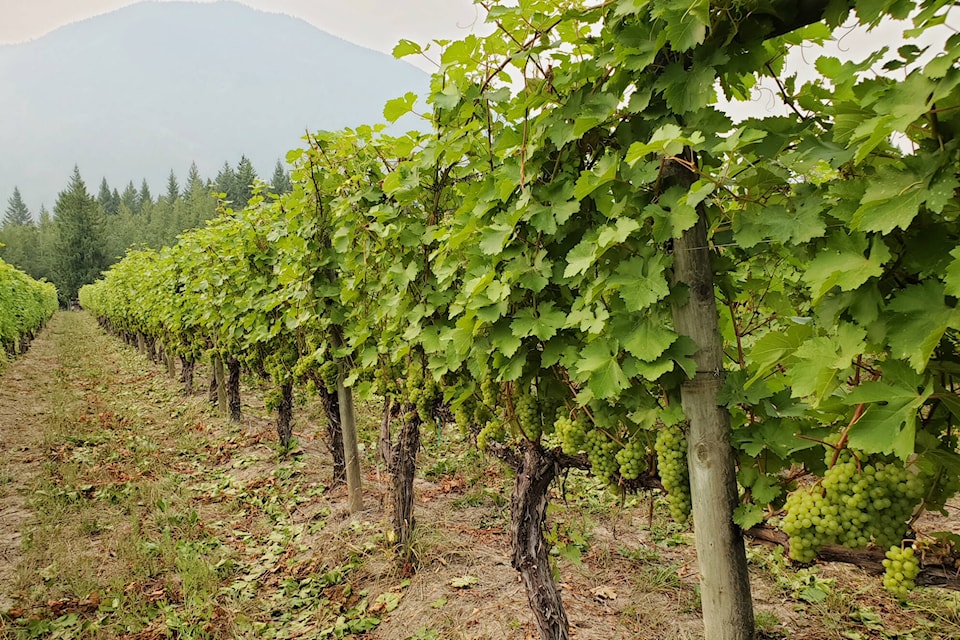By Barb Brouwer
Contributor
Sun, rain and soil play a factor in the quality and taste of wine.
With an increase in wildfires, smoke has become another factor for winemakers to consider and contend with.
The extent to which the smoke from last year’s wildfires added an extra component to Shuswap wines varied from one winery to another.
Recline Ridge winemaker Jaime Flemke said ash was falling on the vineyards like snow and smoke did indeed affect the Tappen winery’s grapes and wine.
“The smoke attaches to the sugars in the grapes but you can’t taste it in the fruit,” she says. “But once yeast is added to the juice to make alcohol, it consumes the sugars and a compound created by the smoke is released into the juice.”
Flemke said the result is dependent on the vineyard, the grape and the winemaking process.
“Sometimes you can taste it right right away and sometimes it takes a while to show up,” she said. “In the whites, smoke can take away from the natural flavours and aromatics of the wine.”
Flemke said three of Recline Ridge’s 2021 whites were affected, as were some reds, but two were not. She hastens to assure that all the wines passed the BC Vintners Quality Alliance Program standards that make them eligible for sale.
South of Salmon Arm and at a higher elevation, Larch Hills Winery owner and self-described labourer John Koopmans said his vineyard was affected by smoke from fires near Sicamous.
“It added a smoky feel to the wine, primarily the white varietals,” he said, pointing out that it’s most evident in the Ortega where there’s also a hint of a smell. “The smoke didn’t particularly affect the wine, but we had to do a bit of work to make sure it was clean. Overall it is a very good vintage.”
Celista Estate Winery owner Jake Ootes said the prevailing winds did not blow a lot of smoke in the direction of his North Shuswap vineyards so his grapes remained basically unaffected.
“The fires were not that close and we left the leaves on the vines until late,” he said, explaining that veraison is the stage at which the skins soften and the grapes become vulnerable. “Once the verasion takes place, the berries start to ripen, and the smoke had disappeared right about that time.”
Ootes said that because the leaves were kept on longer, ash would have fallen on the leaves, not on the grape berries.
Read more: Okanagan winery’s 2021 vintage ruined by wildfire smoke
Read more: Do the Shu: Newly launched website a virtual guide to the Shuswap
“In previous years, we were taking the leaves off around June or early July to give the grapes more sun exposure,” he said, pointing out the winery’s more northerly location in the North Shuswap. “At our location, we have to get as much sunshine as possible.”
Located on Sunnybrae-Canoe Point Rd., Sunnybrae Vineyards and Winery vineyard manager James Clark says grapes are definitely more susceptible to the affects of smoke when veraison takes place and the sugars are developing. At Sunnybrae, smoke was an issue prior to that stage and almost gone when harvesting began in September.
Clark sampled the wine frequently between fermentation that took place in November and last week when the wine was bottled.
“We seem to be fine, but we did do a lot of preventive methods in processing the grapes,” he said, noting that many studies indicate the smoke compound is in the skin. “The main one is to reduce contact with the skins when you’re pressing and crushing them.”
Like many other wineries and juice producers, Sunnybrae has contributed samples to UBC Okanagan where research is underway on the effects of smoke taint.
“There is lot of research being done in Australia and it seems it’s becoming part of farming life over here too,” he said, expressing the hope that 2022 sees far fewer wildfires in the province. “I think most winemakers are thinking about how they can change their winemaking processes just in case.”
lachlan@saobserver.net
Like us on Facebook and follow us on Twitter
Sign up for our newsletter to get Salmon Arm stories in your inbox every morning.
